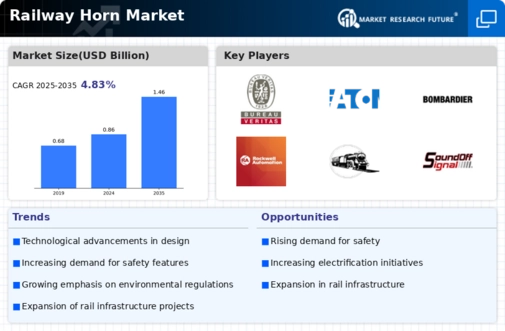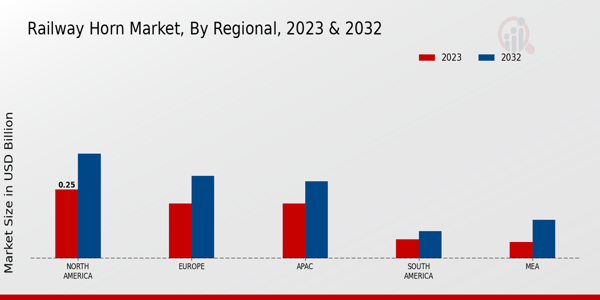Market Trends and Projections
Rising Demand for Safety Features
Safety remains a critical concern in the railway sector, driving the Global Railway Horn Market Industry. The integration of advanced safety features in trains, including high-decibel horns, is becoming increasingly essential to prevent accidents and enhance passenger safety. Regulatory bodies are enforcing stricter safety standards, which necessitates the use of reliable and effective railway horns. This trend is expected to contribute to the market's growth, as manufacturers innovate to meet these safety requirements, thereby potentially increasing the market value to 1.46 USD Billion by 2035.
Increasing Railway Infrastructure Investments
The Global Railway Horn Market Industry is poised for growth due to substantial investments in railway infrastructure across various countries. Governments are prioritizing the development and modernization of rail networks to enhance connectivity and reduce congestion. For instance, countries like India and China are investing heavily in expanding their railway systems, which is likely to increase the demand for railway horns. The market is projected to reach 0.86 USD Billion in 2024, reflecting the positive impact of these investments on the Global Railway Horn Market Industry.
Growing Urbanization and Commuter Rail Systems
Urbanization is a driving force behind the expansion of commuter rail systems, which in turn fuels the Global Railway Horn Market Industry. As cities grow, the demand for efficient public transportation solutions increases, leading to the development of new rail lines and services. This trend necessitates the installation of railway horns to ensure safety and compliance with regulations. The expansion of commuter rail systems is expected to contribute to the market's growth trajectory, as urban areas increasingly rely on rail transport to alleviate traffic congestion.
Technological Advancements in Horn Manufacturing
Technological innovations in the manufacturing processes of railway horns are significantly influencing the Global Railway Horn Market Industry. The adoption of advanced materials and production techniques enhances the durability and performance of horns, making them more efficient and reliable. For example, the use of lightweight composites can improve sound projection while reducing overall weight. This shift towards high-performance horns is likely to attract investments and drive market growth, with a projected CAGR of 4.91% from 2025 to 2035, indicating a robust future for the industry.
Environmental Regulations and Sustainability Initiatives
The Global Railway Horn Market Industry is also shaped by increasing environmental regulations and sustainability initiatives. Governments are encouraging the use of eco-friendly materials and technologies in railway operations, including the production of horns. This shift towards sustainability not only aligns with global environmental goals but also appeals to environmentally conscious consumers. As manufacturers adapt to these regulations, the market may witness a transformation in product offerings, potentially enhancing market growth and expanding the customer base.










